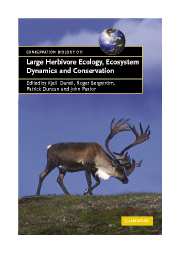Book contents
- Frontmatter
- Contents
- List of contributors
- Preface
- Introduction
- 1 Large herbivores across biomes
- 2 Living in a seasonal environment
- 3 Linking functional responses and foraging behaviour to population dynamics
- 4 Impacts of large herbivores on plant community structure and dynamics
- 5 Long‐term effects of herbivory on plant diversity and functional types in arid ecosystems
- 6 The influence of large herbivores on tree recruitment and forest dynamics
- 7 Large herbivores: missing partners of western European light‐demanding tree and shrub species?
- 8 Frugivory in large mammalian herbivores
- 9 Large herbivores as sources of disturbance in ecosystems
- 10 The roles of large herbivores in ecosystem nutrient cycles
- 11 Large herbivores in heterogeneous grassland ecosystems
- 12 Modelling of large herbivore–vegetation interactions in a landscape context
- 13 Effects of large herbivores on other fauna
- 14 The future role of large carnivores in terrestrial trophic interactions: the northern temperate view
- 15 Restoring the functions of grazed ecosystems
- 16 Themes and future directions in herbivore‐ecosystem interactions and conservation
- Index
- References
11 - Large herbivores in heterogeneous grassland ecosystems
Published online by Cambridge University Press: 16 November 2009
- Frontmatter
- Contents
- List of contributors
- Preface
- Introduction
- 1 Large herbivores across biomes
- 2 Living in a seasonal environment
- 3 Linking functional responses and foraging behaviour to population dynamics
- 4 Impacts of large herbivores on plant community structure and dynamics
- 5 Long‐term effects of herbivory on plant diversity and functional types in arid ecosystems
- 6 The influence of large herbivores on tree recruitment and forest dynamics
- 7 Large herbivores: missing partners of western European light‐demanding tree and shrub species?
- 8 Frugivory in large mammalian herbivores
- 9 Large herbivores as sources of disturbance in ecosystems
- 10 The roles of large herbivores in ecosystem nutrient cycles
- 11 Large herbivores in heterogeneous grassland ecosystems
- 12 Modelling of large herbivore–vegetation interactions in a landscape context
- 13 Effects of large herbivores on other fauna
- 14 The future role of large carnivores in terrestrial trophic interactions: the northern temperate view
- 15 Restoring the functions of grazed ecosystems
- 16 Themes and future directions in herbivore‐ecosystem interactions and conservation
- Index
- References
Summary
INTRODUCTION
Satisfying energetic and nutritional requirements is a difficult challenge for herbivores in grassland. Grass is a relatively abrasive, low‐quality forage (Van Soest 1982, Robbins 1983, McDowell 1985) whose nutritional content varies over complex spatial and temporal scales (Houston 1982, Hudson & White 1985, McNaughton 1985, Laca & Dement 1986, Senft et al. 1987, Demment & Greenwood 1988, Hobbs 1989, Singer et al. 1989). Ungulates, the principal large herbivores of grassland, are well suited for the dietary rigours of their habitat by possessing three important adaptations: (1) high‐crowned, hypsodontic dentition that resists wear and increases the capacity for long‐lived organisms to grind plant tissue; (2) a multichambered digestive tract that functions as a fermentation vat to efficiently extract energy from high cellulose ingesta; and (3) an elongation of limbs, reduction of digits and the development of a massive, hardened nail, the hoof, that provides for efficient and injury‐resistant travel over open terrain in search of food (Van Soest 1982, McNaughton 1989, 1991). This suite of adaptations facilitates energy and nutrient extraction from forage, and is testimony to the severe resource‐limiting conditions that ungulates face in a grassland habitat.
There has been considerable recent interest in factors controlling the development and maintenance of a spatial pattern in landscapes, and the flows of energy and material among landscape patches (Levin 1992, Pickett & Cadenasso 1995, Turner et al. 2001).
- Type
- Chapter
- Information
- Large Herbivore Ecology, Ecosystem Dynamics and Conservation , pp. 326 - 347Publisher: Cambridge University PressPrint publication year: 2006
References
- 7
- Cited by

